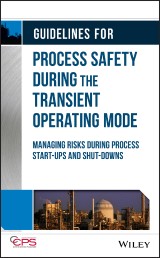Details

Guidelines for Process Safety During the Transient Operating Mode
Managing Risks during Process Start-ups and Shut-downs1. Aufl.
|
131,99 € |
|
| Verlag: | Wiley |
| Format: | |
| Veröffentl.: | 28.01.2021 |
| ISBN/EAN: | 9781119529217 |
| Sprache: | englisch |
| Anzahl Seiten: | 288 |
DRM-geschütztes eBook, Sie benötigen z.B. Adobe Digital Editions und eine Adobe ID zum Lesen.
Beschreibungen
<p><b>Prevent operational incidents and reduce risks with an essential CCPS guide</b></p> <p>You can help your company reduce its operating risks by learning how to effectively manage transient operations and avoid major incidents. Startups and shutdowns, known as transient operations, can be high-risk periods for manufacturing facilities. <i>Guidelines for Process Safety During Transient Operations</i> offers useful guidance in preparing for the safe startup and shutdown of chemical processes. With an understanding of the risks involved, you can work proactively to prevent fatalities, serious injuries, reduced productivity, and costly damage.</p> <p>This essential guide for plants provides clear examples of how to anticipate and avoid major issues. The book examines safe shutdown procedures in the event of an emergency. You will also gain direction on how to resume operations safely after an unexpected shutdown. The book supports anyone tasked with regulating and overseeing chemical plants and procedures, whether you are an engineer, manager, or government professional.</p> <ul> <li>Minimize operating risks through the effective management of transient operations</li> <li>Establish safe start-up and shutdown procedures for chemical processes</li> <li>Be ready to safely shut down processes in the event of an emergency</li> <li>Learn from real world examples of start-up or shutdown incidents</li> <li>Review procedures and engineering controls that help prevent or reduce the effects of incidents involving transient operations</li> </ul> <p><i>Guidelines for Process Safety</i> comes to you from The Center for Chemical Process Safety (CCPS), which offers advanced thinking in the critical area of process safety. The organization develops technology and management practices for companies seeking to reduce hazards within the chemical and petrochemical industries.</p>
<p>List of Figures x iii</p> <p>List of Tables xv</p> <p>Acronyms and Abbreviations x vii</p> <p>Glossary xix</p> <p>Acknowledgments xxv</p> <p>Dedication x xvii</p> <p>Foreword xxix</p> <p>Preface x xxiii</p> <p><b>1 Introduction 1</b></p> <p>1.1 Introduction 1</p> <p>1.2 Scope 1</p> <p>1.3 Audience 5</p> <p>1.4 Benefits 6</p> <p>1.5 Applying CCPS Risk Based Process Safety (RBPS) 6</p> <p>1.6 Incident discussions and guidance 7</p> <p>1.7 Framework 8</p> <p><b>2 Defining the Transition Times 16</b></p> <p>2.1 Introduction 16</p> <p>2.2 Defining the modes of operation 16</p> <p>2.3 Responses to deviations during operations 17</p> <p>2.4 A start-up incident 23</p> <p><b>Part I—Normal Operations</b></p> <p><b>3 Normal Operations 29</b></p> <p>3.1 Introduction 29</p> <p>3.2 The normal operation 29</p> <p>3.3 Procedures 37</p> <p>3.4 Performing a normal shut-down 39</p> <p>3.5 Start-up after a normal shut-down 40</p> <p>3.6 Incidents and lessons learned 41</p> <p>3.7 How the RBPS elements apply 43</p> <p><b>4 Process Shutdowns 45</b></p> <p>4.1 Introduction 45</p> <p>4.2 The process shutdown 46</p> <p>4.3 Projects requiring equipment or process unit shutdowns 48</p> <p>4.4 A brief project life cycle phase overview 52</p> <p>4.5 Preparing for planned project-related shutdowns 62</p> <p>4.6 Start-up after planned project-related shutdowns 66</p> <p>4.7 Incidents and lessons learned 69</p> <p>4.8 How the RBPS elements apply 72</p> <p><b>5 Facility Shutdowns 73</b></p> <p>5.1 Introduction 73</p> <p>5.2 The facility shutdown 73</p> <p>5.3 Projects requiring a process unit or facility project-related shutdown 75</p> <p>5.4 Preparing for a facility project-related shutdown 80</p> <p>5.5 Start-up after a facility project-related shutdown 81</p> <p>5.6 Incidents and lessons learned 83</p> <p>5.7 How the RBPS elements apply 95</p> <p><b>Part II—Abnormal and Emergency Operations </b></p> <p><b>6 Recovery 99</b></p> <p>6.1 Introduction 99</p> <p>6.2 Recovering from an abnormal operation 99</p> <p>6.3 Anticipating abnormal operations 100</p> <p>6.4 Managing abnormal operations 103</p> <p>6.5 Incidents and lessons learned 110</p> <p>6.6 How the RBPS elements apply 113</p> <p><b>7 Unscheduled Shutdowns 115</b></p> <p>7.1 Introduction 115</p> <p>7.2 Unscheduled shutdowns 115</p> <p>7.3 Anticipating and preparing for unscheduled shutdowns 116</p> <p>7.4 Start-up after activating an unscheduled shut-down 119</p> <p>7.5 Managing unscheduled shutdowns caused by natural hazard events 121</p> <p>7.6 Incidents and lessons learned 126</p> <p>7.7 How the RBPS elements apply 139</p> <p><b>8 Emergency Shutdowns 141</b></p> <p>8.1 Introduction 141</p> <p>8.2 Emergency shutdowns 141</p> <p>8.3 Safely responding to an incident 142</p> <p>8.4 Anticipating and preparing for shut-downs in an emergency 143</p> <p>8.5 Start-up after an emergency shutdown 150</p> <p>8.6 Incidents and lessons learned 153</p> <p>8.7 How the RBPS elements apply 156</p> <p><b>Part III—Other Considerations</b></p> <p><b>9 Other Transition Time Considerations 159</b></p> <p>9.1 Introduction 159</p> <p>9.2 A Life Cycle overview 160</p> <p>9.3 Commissioning and initial start-up considerations 167</p> <p>9.4 Incidents and lessons learned, commissioning and initial start-ups 174</p> <p>9.5 End-of-life shut-down considerations 179</p> <p>9.6 Mothballing considerations 182</p> <p>9.7 Incidents and lessons learned, mothballing 183</p> <p>9.8 Decommissioning considerations 184</p> <p>9.9 Incidents and lessons learned, decommissioning 185</p> <p>9.10 How the RBPS elements apply 186</p> <p><b>10 Risk Based Process Safety (RBPS) Considerations 187</b></p> <p>10.1 Introduction 187</p> <p>10.2 An RBPS Overview 189</p> <p>10.3 Applying RBPS to each transient operating mode 194</p> <p>10.4 Effects of weak operational discipline 204</p> <p>10.5 Approach for improving process safety performance 205</p> <p><b>Appendix A 209</b></p> <p>Transient operating modes: incident review and guidance 209</p> <p>A.1 Introduction 209</p> <p>A.2 Review of incidents during transient operating modes 209</p> <p>A.3 Managing the unexpected during transient operating modes 223</p> <p>References 237</p> <p>Index 250</p>
<p>The <b>Center for Chemical Process Safety (CCPS)</b> was founded in 1985 to develop technology and management practices that mitigate or eliminate process safety incidents in the chemical and petrochemical industries. Since that time, CCPS has published more than 100 books and held dozens of international conferences, each representing the most advanced thinking in process safety. CCPS is supported by the contributions and voluntary participation of more than 200 companies globally. CCPS is also the world's largest provider of undergraduate engineering curriculum materials through its SAChE program, with more than 160 universities participating from around the world.</p>


















